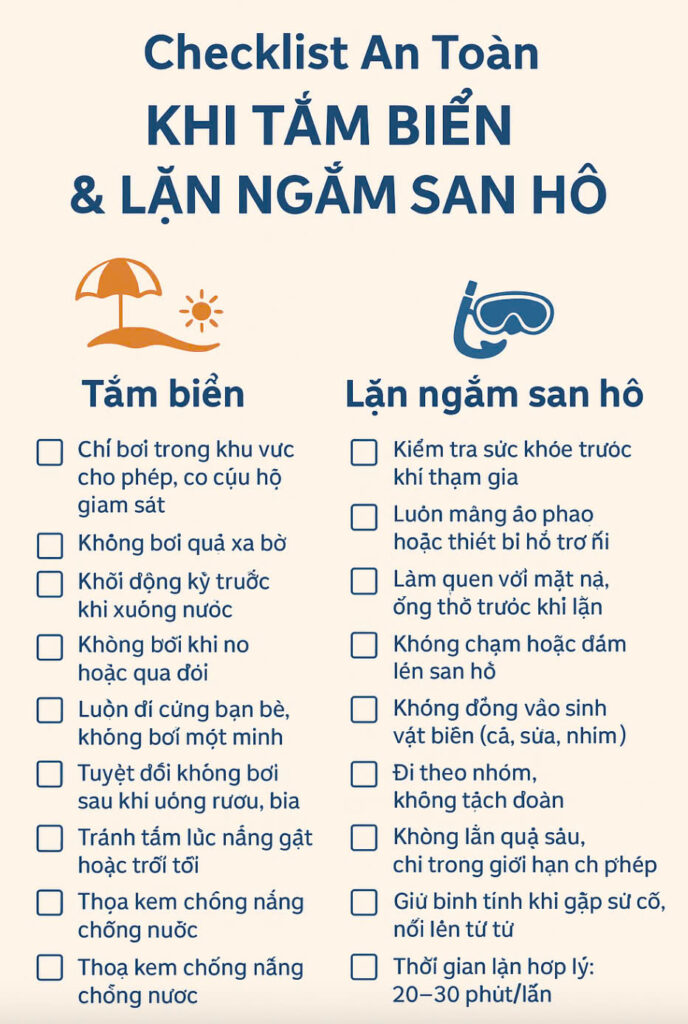Health & Safety Guidelines for Swimming and Coral Reef Snorkeling at Cham Island
When traveling to Cham Island, especially if you’re planning to swim or snorkel among the coral reefs, it’s worth taking a few minutes to understand some basic health and safety guidelines. These simple precautions may seem obvious, but they make all the difference in keeping your trip safe, enjoyable, and unforgettable.
First of all, swim only in designated areas where lifeguards are on duty, and never go swimming after drinking alcohol. Even if you’re a strong swimmer, avoid going too far from the shore — the sea can hide unpredictable undercurrents. Make sure to stretch and warm up before getting into the water, and avoid swimming right after a heavy meal or when your body feels tired.

For those joining a Cu Lao Cham tour with snorkeling by speed boat, the top priority is keeping both yourself and the marine environment safe. Always wear a life jacket, and get familiar with your mask and snorkel before entering the water. Do not touch, step on, or break the corals — not only does it damage the reef, but it can also cause scratches or allergic reactions.
Always stay with your guide and the group, and never dive deeper than the allowed range (around 3–5 meters). A simple tip: stay calm, breathe slowly, and ascend gradually if you encounter any problem underwater.
Following these swimming and snorkeling safety rules during your Cham island daily tour not only protects you but also shows respect for the ocean — a living world where every clear wave and colorful coral reef deserves to be preserved for sustainable tourism and future generations.

While Swimming
- Follow the lifeguard’s instructions – Always stay within the designated swimming area marked by buoys or safety flags.
- Don’t swim too far from shore – Especially when the waves are strong or you’re not wearing a life vest.
- Warm up before getting in the water – Stretch your body to prevent cramps.
- Avoid swimming right after eating or on an empty stomach – A full stomach may cause discomfort, while an empty one can make you lightheaded.
- Never swim alone – Always go with a friend or family member so you can help each other if needed.
- Say no to alcohol before swimming – It reduces awareness and increases the risk of drowning.
- Choose the right time to swim – Avoid swimming under harsh midday sun or after 6 p.m. when visibility drops.
- Apply waterproof sunscreen – Protect your skin from sunburn and dehydration.

While Snorkeling or Diving to See Coral Reefs
- Check your health condition first – Those with heart disease, high blood pressure, asthma, or sinus problems should not participate.
- Always wear a life vest or buoyancy aid – Even if you’re a good swimmer.
- Get comfortable with your mask and snorkel – Practice breathing before entering the water.
- Do not touch or step on corals – They are fragile and can injure you while being easily damaged.
- Keep a safe distance from marine life – Don’t chase, grab, or disturb sea creatures like jellyfish, starfish, or sea urchins.
- Stay close to your group and follow your guide – Never dive off on your own.
- Respect the depth limit – For snorkeling, stay within 3–5 meters below the surface.
- Stay calm underwater – If water leaks into your mask or snorkel, rise slowly and signal for help if needed.
- Limit each dive to 20–30 minutes – Give your body time to rest between sessions.
- Protect the ocean environment – Do not litter or collect coral and sea creatures as souvenirs.



